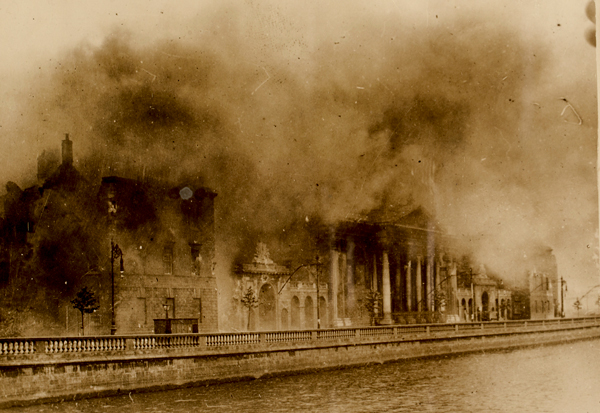Four Courts shelled by Free State troops as Dublin erupts in worst violence since 1916
Dublin, 29 June 1922 – The centre of Dublin City has descended into violence – the fiercest since Easter week, 1916 – after Free State troops launched an attack on positions held by anti-treaty forces.
The iconic Four Courts has been at the centre of the Free State operation. The building, which has been occupied by anti-treaty forces led by Rory O’Connor since April, was subjected to a sustained artillery bombardment that began at dawn yesterday. Considerable damage has already been done to the building and it has been reported that there have many casualties, including civilians.
Preparation for the assault on the Four Courts began with the suspension of the telephone system across Dublin in the early hours of the morning. Entrenchments with barbed wire entanglements were established in front and around the Four Courts.

Armoured car on Henry Street, Dublin (Image: National Library of Ireland, July 1922)
An estimated force of 1,000 Free State troops, accompanied by two armoured cars and a number of armoured lorries, took up positions on the quays on the south side of the Liffey and on principal streets on the north side. Troops also occupied houses at particular vantage points, requiring residents to leave. At 3am a message was sent to the officer in charge of the Four Courts ordering them to immediately release Lt General J.J. O’Connell, Assistant Chief of Staff, who had been kidnapped earlier in the week. A further order was issued for the Four Courts to be evacuated and the occupants’ arms and ammunition to be surrendered. The anti-treaty, or irregular, forces were given one hour to comply. When they didn’t, the bombardment began.
Michael Collins, Chairman of the Irish Provisional Government, has defended the actions of the Free State troops as ‘absolutely necessary’. Speaking to a representative of the International News Service of America, Mr Collins claimed that the provisional government had ‘borne with extreme patience the illegal and improper conduct of certain elements in our midst since the signing of the treaty with Great Britain and its endorsement by the Supreme Authority of the nation – Dáil Éireann.’
He added that the reluctance of the government to take action against these elements had left them open to the charge of ‘neglecting our duty to our citizens’ and that events had been brought to a head by recent incidents in Dublin, notably the ‘raiding and plundering...of one of the principal garages in the metropolis under the pretext of enforcing a boycott against Belfast’ and the kidnapping of Lt General O’Connell by the same people. ‘It was now obvious that we could no longer tolerate glaring outrages of this nature against the people and the people’s government.’
At the same time as the Dáil forces opened fire on the Four Courts they did likewise on Fowler Memorial Hall, which was also occupied by irregular troops.
It is reported that 14 people were killed and about 30 wounded on the opening day of the battle.
Pathé newsreel footage Bombarding the Four Courts of Dublin (1922)
[Editor's note: This is an article from Century Ireland, a fortnightly online newspaper, written from the perspective of a journalist 100 years ago, based on news reports of the time.]





















